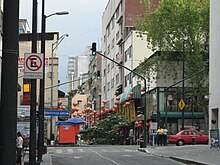Barrio Chino
Chinatowns in Latin America (Spanish: barrios chinos, singular barrio chino / Portuguese: bairros chineses, singular bairro chinês) developed with the rise of Chinese immigration in the 19th century to various countries in Latin America as contract laborers (i.e., indentured servants) in agricultural and fishing industries. Most came from Guangdong Province. Since the 1970s, the new arrivals have typically hailed from Hong Kong, Macau, and Taiwan. Latin American Chinatowns may include the descendants of original migrants — often of mixed Chinese and Latino parentage — and more recent immigrants from East Asia. Most Asian Latin Americans are of Cantonese and Hakka origin. Estimates widely vary on the number of Chinese Descendants in Latin America but it is at least 1.4 million and likely much greater than this.
Unlike the Chinatowns of Anglo America and Europe, pure-blood ethnic Chinese were relatively few in number but now increasing rapidly due to generally lower levels of Chinese immigration to some parts of Latin America. Residents of Latin American Chinatowns tend to be multilingual. Latin America's Chinatowns include those of Mexico City, Havana, Buenos Aires, and Lima. Some of these Chinatowns mainly serve as tourist attractions and not as true, living ethnic communities. The Chinatown of Havana, Cuba's is largely multi-generation Spanish-speaking Chinese Cuban whereas the Chinatown of the Belgrano district of Buenos Aires, Argentina consists of many first-generation Holo- and Mandarin-speaking immigrants from Taiwan.
...
Wikipedia

